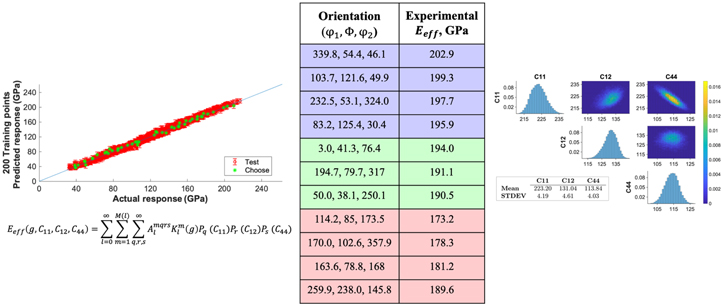Crossref Citations
This article has been cited by the following publications. This list is generated based on data provided by
Crossref.
Kalidindi, Surya R.
Khosravani, Ali
Yucel, Berkay
Shanker, Apaar
and
Blekh, Aleksandr L.
2019.
Data Infrastructure Elements in Support of Accelerated Materials Innovation: ELA, PyMKS, and MATIN.
Integrating Materials and Manufacturing Innovation,
Vol. 8,
Issue. 4,
p.
441.
Kalidindi, Surya R.
2020.
Feature engineering of material structure for AI-based materials knowledge systems.
Journal of Applied Physics,
Vol. 128,
Issue. 4,
Venkatraman, Aditya
Montes de Oca Zapiain, David
and
Kalidindi, Surya R.
2020.
Reduced-Order Models for Ranking Damage Initiation in Dual-Phase Composites Using Bayesian Neural Networks.
JOM,
Vol. 72,
Issue. 12,
p.
4359.
Peerless, James S.
Sevgen, Emre
Edkins, Stephen D.
Koeller, Jason
Kim, Edward
Kim, Yoolhee
Gargt, Astha
Antono, Erin
and
Ling, Julia
2020.
Design space visualization for guiding investments in biodegradable and sustainably sourced materials.
MRS Communications,
Vol. 10,
Issue. 1,
p.
18.
Voigt, Sven P.
and
Kalidindi, Surya R.
2021.
Materials graph ontology.
Materials Letters,
Vol. 295,
Issue. ,
p.
129836.
Vu, Giao
Diewald, Fabian
Timothy, Jithender J.
Gehlen, Christoph
and
Meschke, Günther
2021.
Reduced Order Multiscale Simulation of Diffuse Damage in Concrete.
Materials,
Vol. 14,
Issue. 14,
p.
3830.
Basu, Bikramjit
Gowtham, N. H.
Xiao, Yang
Kalidindi, Surya R.
and
Leong, Kam W.
2021.
Biomaterialomics: Data-Driven Pathways to Next-Generation Biomaterials.
SSRN Electronic Journal ,
Kaundinya, Prathik R.
Choudhary, Kamal
and
Kalidindi, Surya R.
2021.
Machine learning approaches for feature engineering of the crystal structure: Application to the prediction of the formation energy of cubic compounds.
Physical Review Materials,
Vol. 5,
Issue. 6,
Kelly, Conlain
and
Kalidindi, Surya R.
2021.
Recurrent localization networks applied to the Lippmann-Schwinger equation.
Computational Materials Science,
Vol. 192,
Issue. ,
p.
110356.
Seibert, Paul
Ambati, Marreddy
Raßloff, Alexander
and
Kästner, Markus
2021.
Reconstructing random heterogeneous media through differentiable optimization.
Computational Materials Science,
Vol. 196,
Issue. ,
p.
110455.
Hashemi, Sepideh
and
Kalidindi, Surya R.
2021.
A machine learning framework for the temporal evolution of microstructure during static recrystallization of polycrystalline materials simulated by cellular automaton.
Computational Materials Science,
Vol. 188,
Issue. ,
p.
110132.
Rixner, Maximilian
and
Koutsourelakis, Phaedon-Stelios
2022.
Self-supervised optimization of random material microstructures in the small-data regime.
npj Computational Materials,
Vol. 8,
Issue. 1,
Morand, Lukas
Link, Norbert
Iraki, Tarek
Dornheim, Johannes
and
Helm, Dirk
2022.
Efficient Exploration of Microstructure-Property Spaces via Active Learning.
Frontiers in Materials,
Vol. 8,
Issue. ,
Zhao, Jiajun
Li, Junjie
Hu, Xiaobing
Wang, Yujian
Chen, Yiming
He, Feng
Wang, Zhijun
Zhao, Zhanglong
and
Wang, Jincheng
2022.
Establishing reduced-order process-structure linkages from phase field simulations of dendritic grain growth during solidification.
Computational Materials Science,
Vol. 214,
Issue. ,
p.
111694.
Basu, Bikramjit
Gowtham, N.H.
Xiao, Yang
Kalidindi, Surya R.
and
Leong, Kam W.
2022.
Biomaterialomics: Data science-driven pathways to develop fourth-generation biomaterials.
Acta Biomaterialia,
Vol. 143,
Issue. ,
p.
1.
Ye, Jiahui
Mahmoudi, Mohamad
Karayagiz, Kubra
Johnson, Luke
Seede, Raiyan
Karaman, Ibrahim
Arroyave, Raymundo
and
Elwany, Alaa
2022.
Bayesian Calibration of Multiple Coupled Simulation Models for Metal Additive Manufacturing: A Bayesian Network Approach.
ASCE-ASME Journal of Risk and Uncertainty in Engineering Systems, Part B: Mechanical Engineering,
Vol. 8,
Issue. 1,
Qian, Xiaoning
Yoon, Byung-Jun
Arróyave, Raymundo
Qian, Xiaofeng
and
Dougherty, Edward R.
2023.
Knowledge-driven learning, optimization, and experimental design under uncertainty for materials discovery.
Patterns,
Vol. 4,
Issue. 11,
p.
100863.
Barry, Matthew C.
Kumar, Satish
and
Kalidindi, Surya R.
2023.
Machine Learning in Molecular Sciences.
Vol. 36,
Issue. ,
p.
67.
Hashemi, Sepideh
and
Kalidindi, Surya R.
2023.
Gaussian process autoregression models for the evolution of polycrystalline microstructures subjected to arbitrary stretching tensors.
International Journal of Plasticity,
Vol. 162,
Issue. ,
p.
103532.
Barry, Matthew C.
Gissinger, Jacob R.
Chandross, Michael
Wise, Kristopher E.
Kalidindi, Surya R.
and
Kumar, Satish
2023.
Voxelized atomic structure framework for materials design and discovery.
Computational Materials Science,
Vol. 230,
Issue. ,
p.
112431.



